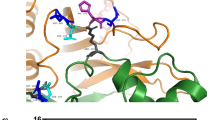Abstract
THE basis for the complex multiple molecular forms (isozymes) of the enzyme adenosine deaminase (ADA) has been widely studied. The ADA found in human erythrocytes (so-called ‘red cell’ ADA) exhibits genetically determined polymorphism detectable by electrophoresis1, has reactive thiol groups2 and has a low molecular size3.‘Red cell’ ADA is present in various tissues other than the red cell3, but additional adenosine deaminases. the so-called tissue ADA isozymes a, b, c, d and e named in order of decreasing electrophoretic mobility, which exhibit rather different properties. occur in varying amounts in nonerythroid tissues. With the discovery that the deficiency of ‘red cell’ ADA in certain patients with combined immune deficiency disease is accompanied by the deficiency of all the other isozymes4–6. it became clear that all the forms were probably coded by a single ADA locus. The ‘red cell’ ADA can be converted into the characteristic ‘tissue’ isozymes by tissue extracts both from normal individuals7,8 and from patients with combined immune deficiency disease. A converting factor has been isolated and partially purified and is thought to be a protein9. This protein is presumably associated with one or several ‘red cell’ ADA molecules to form the ‘tissue’ isozymes, accounting for the alteration in properties (increase in molecular size, loss of detectable genetically determined electrophoretic variation and loss of thiol reactivity3). We present here evidence, from lectin affinity chromatography and experiments with neuraminidase. that most of the multiple forms of ‘tissue’ ADA are glycoproteins which differ in their accessible sugar residues. This suggests that the converting factor may be a single glycoprotein with heterogenous carbohydrate content.
This is a preview of subscription content, access via your institution
Access options
Subscribe to this journal
Receive 51 print issues and online access
$199.00 per year
only $3.90 per issue
Buy this article
- Purchase on Springer Link
- Instant access to full article PDF
Prices may be subject to local taxes which are calculated during checkout
Similar content being viewed by others
References
Spencer, N., Hopkinson, D. A. & Harris, H. Ann. hum. Genet. 32, 9 (1968).
Hopkinson, D. A. & Harris, H. Ann. hum. Genet. 33, 81 (1969).
Edwards, Y. H., Hopkinson, D. A. & Harris, H. Ann. hum. Genet. 35, 207 (1971).
Giblett, E. R., Anderson, J. E., Cohen, F., Pollara, P. & Meuwissen, H. J., Lancet ii, 1067 (1972).
Hirschhorn, R., Levytska, V., Pollara, B. & Meuwissen, H. J. Nature new Biol. 246, 200 (1973).
Chen, S. H., Scott, C. R. & Giblett, E. R. Am. J. hum. Genet. 26, 103 (1974).
Hirschhorn, R. J. clin. Invest. 55, 661 (1975).
Akedo, H., Nishihara, H. K., Komatsu, K. & Ishikawa, S. Biochem. biophys. Acta 276, 257 (1972).
Nishihara, H., Ishikawa, S., Shinkai, K. & Akedo, H. Biochem. biophys. Acta 302, 429 (1973).
Lloyd, K. O., Kabat, E. A. & Beychok, S. J. Immun. 102. 1354 (1969).
Krusius, T., Finne, J. & Rauvala, H. FEBS Lett. 71, 117 (1976).
Greenway, P. J. & LeVine, D. Nature new Biol. 241, 191 (1973).
Author information
Authors and Affiliations
Rights and permissions
About this article
Cite this article
SWALLOW, D., EVANS, L. & HOPKINSON, D. Several of the adenosine deaminase isozymes are glycoproteins. Nature 269, 261–262 (1977). https://doi.org/10.1038/269261a0
Received:
Accepted:
Issue Date:
DOI: https://doi.org/10.1038/269261a0
This article is cited by
-
Regional localization ofDPP4 (aliasCD26 andADCP2) to chromosome 2q24
Somatic Cell and Molecular Genetics (1994)
-
Human biochemical genetics of enzyme proteins in the new age of molecular genetics
Journal of Inherited Metabolic Disease (1986)
-
Tumor progression in metastasis: an experimental approach using lectin resistant tumor variants
Cancer and Metastasis Review (1982)
-
Assignment of adenosine deaminase complexing protein (ADCP) gene(s) to human chromosome 2 in rodent-human somatic cell hybrids
Human Genetics (1981)
-
Enzyme defects in immunodeficiency diseases
Springer Seminars in Immunopathology (1978)
Comments
By submitting a comment you agree to abide by our Terms and Community Guidelines. If you find something abusive or that does not comply with our terms or guidelines please flag it as inappropriate.



